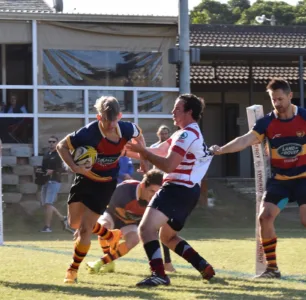Rugby is a fast-paced and physically demanding sport that requires a high level of skill, strategy, and teamwork. One of the most important aspects of rugby is defence, and a key strategy in defensive play is line speed. Line speed is the ability of a team’s defensive line to move quickly up the field and put pressure on their opponents, disrupting their attacking play and forcing mistakes.
There are several key components of line speed, including communication, positioning, and agility. Effective communication is critical in ensuring that the defensive line moves together as a cohesive unit, with each player knowing their role and responsibilities. Positioning is also important, with defenders needing to be in the right place at the right time to shut down their opponents’ attacking options.
Agility is another important component of line speed, with defenders needing to be able to move quickly and change direction to stay with their opponents. This requires not only physical fitness but also good footwork and coordination.
Developing line speed requires a lot of practice and training, both individually and as a team. One effective training method is the “shadow” drill, where players practise moving up the field together in a coordinated fashion, focusing on communication, positioning, and agility. Another important aspect of training is developing a strong team culture and a shared understanding of defensive strategies and tactics.
Line speed can be a game-changer in rugby, allowing teams to disrupt their opponents’ attacking play and gain the upper hand. By developing effective communication, positioning, and agility, and practising as a team, players can improve their line speed and become more effective defenders. With the right training and strategy, any team can develop a strong defensive line and gain an advantage on the field.
How to improve line speed without going offside
Improving line speed is an important aspect of defensive play in rugby, but it’s also important to avoid going offside, as this can result in a penalty for your team. Here are some tips on how to improve your line speed without going offside:
- Work on your communication: Effective communication is crucial in ensuring that the defensive line moves up the field together as a cohesive unit. Make sure you and your teammates are communicating with each other, both verbally and through body language, to ensure that everyone is on the same page.
- Improve your anticipation: Anticipation is key to getting the timing right when moving up the field. Watch the body language and movements of the opposition to anticipate when they will pass the ball, and move up accordingly.
- Focus on your body positioning: Your body positioning is crucial to avoiding going offside. Stay behind the last foot of the ruck or maul, and make sure that your feet are behind the ball when it’s kicked or passed. Keeping your body low and balanced will also help you react quickly and avoid going offside.
- Improve your speed and agility: Improving your speed and agility will help you get to the breakdown or the opposing player more quickly, without sacrificing control or balance. This will allow you to put pressure on the opposition without risking going offside.
- Practice with your team: Practice is key to improving your line speed and avoiding going offside. Work with your team to develop drills and strategies that focus on improving your line speed while staying onside. This will help build muscle memory and develop good habits on the field.
Improving your line speed while staying onside takes practice and focus. By working on your communication, anticipation, body positioning, speed, and agility, you can improve your line speed and become a more effective defender, while avoiding the costly penalty of going offside.
How can attackers overcome line speed
Line speed is a crucial aspect of defensive play in rugby, as it can disrupt the opposition’s attacking play and force errors. However, attackers can use a range of strategies to overcome line speed and create opportunities for their team. Here are some ways that attackers can overcome line speed in rugby:
- Use quick ball: Quick ball is a key tool in disrupting the opposition’s defensive line. If the ball is moved quickly and efficiently from the ruck or maul, it can catch defenders off guard and create gaps in the defensive line.
- Change the point of attack: If the opposition’s defensive line is particularly strong in one area, changing the point of attack can catch them off guard and create opportunities for the attacking team. This can be done by using cross-field kicks, switching the direction of play, or exploiting gaps on the weak side of the field.
- Use dummy runners: Dummy runners are players who run with the ball but have no intention of receiving a pass. They can be used to draw defenders out of position and create space for the attacking team to exploit.
- Use misdirection: Misdirection is a tactic that involves creating the illusion that the ball is going in one direction, while in reality, it’s going in another. This can be achieved through feints, dummy passes, or other deceptive movements that can create confusion in the defensive line.
- Use offloads: Offloading the ball in contact can catch defenders off guard and create opportunities for the attacking team. By using quick, accurate offloads, attackers can keep the ball alive and create space for their teammates.
- Use kicking as a weapon: Kicking can be an effective way to bypass the opposition’s defensive line and create opportunities for the attacking team. Kicks can be used to find space behind the defensive line, force defenders to retreat, or create attacking opportunities on the weak side of the field.
Overall, attackers can overcome line speed by using a combination of quick ball, misdirection, dummy runners, offloads, and kicking as a weapon. By using these tactics effectively, attackers can create gaps in the defensive line and create opportunities for their team to score.

